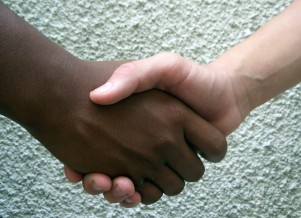Duty of Fraternity
Article By Harianto Mehta

As the summer months climax with the annual monsoons breathing fresh life into the soil, Nature renews her promise to every being in her domain. It is a promise of continuity, and as if by magic, life vibrantly awakes, and breaks into song, with every creature, every plant, and every spirit dancing together in unison. How wonderful that tradition in India commemorates this unity of life with a celebration to nurture fraternity amongst human beings; the celebration of Raksha Bandhan. But what really is fraternity? How does it relate to unity? Why was it recognized as such a fundamental value, that the ancient elders planted it deep within the sub-continent’s cultural landscape?
The difficulty of understanding the true meaning of fraternity, perhaps originates in the misconstrued notion of equality so prevalent in our times. Equality is often misunderstood as a sort of absolute homogeneity which our governments and educational systems struggle to uphold. To avert injustice, we try to give every member of society the same resources, and his/her success is judged by the same parameters, regardless of differences in age, gender, aptitude, etc. What results, however, is a futile rat-race that inevitably favors certain individuals, leaving others side-lined or even outcast. Very quickly it becomes evident that what started out as the spirit of equality, collapses into an ineffective and competitive arena, in which the individual advancement is prized over collective prosperity.
In contrast, Plato observes that the needs of each person in a human community are different. A mother might grasp easily that of her two children, one requires a lot of help with studies, while the other manages to complete assignments easily and quickly. Giving a single hour of tutoring to each child in such a scenario, would be equal…but it is clear that it would be unjust. Hence, Plato proposes giving to each member of the community according to his/her needs so as to enable each person to really be the best that he/she can be.
Similarly, even the most elementary observation of nature reveals that every being is in fact different, and therefore it is not possible to regard them as equal. Can we say that the sun is equal to the moon? Can we say that a river is equal to a mountain? Is it not ridiculous to claim that an eagle is equal to a monkey? Undeniably, we recognize that at a fundamental level, these are all beings of nature, all manifestations of life – and the spirit that inhabits each manifestation originates from the same source, and is destined for the same end. In that sense, indeed they are all spiritually equal. However, it is also apparent that within the wondrous plurality of expression, each being has its own unique qualities, character, and needs; most importantly, each being has a unique purpose within the ecosystem that it inhabits. Therefore nature thrives not on equality, but on the complementary nature of the beings in her domain.
Perhaps in this unequal, yet wonderfully synchronous relationship between all entities of nature lies the secret of fraternity. Interestingly, every creature uses nature’s resources in impeccably efficient measure, in turn serving her by meticulously performing a unique purpose for the welfare of the collective. Together, an ecosystem emerges, a harmonic unity, dependant not on the equality of its components, but on the inter-connected relationship between them.
However, one can argue that creatures in nature act out of instinct, a sort of automated compulsion, in performing their duty. This is true, and herein lies the glory of being human. A human being can employ the power of will and freely choose to participate in this collective, in spite of our many vices that may tempt us to first serve ourselves. Amongst human beings, this collective can be defined as a fraternity wherein each individual cherishes the diversity, and transcends it by fulfilling his/her obligations to the community. Therefore, amongst the various nationalities, ethnicities, languages, professions, we seem to have a collective role to play in the larger context of life. Each individual fulfils this role to the best of his/her ability. Building a fraternity is therefore a privilege, even a duty, and emerging victorious from the treacherous battle between the temptations of the lower self, in favor of the collective fraternity requires discipline and persistence.
It is evident that ancient Hindus appreciated this obligation, and wove it into the annual cycle of the seasons, developing a custom celebrating fraternity, to resonate with its annual expression in nature. They divided the year into 4 parvas (meaning height or climax, etymological root: parvat, or mountain), each offering a unique opportunity for Man to celebrate a special moment, in correspondence with the peak in energy brought about by each season. The first of these, the rakhi parva or Raksha-Bandhan (the knot of protection), is commonly marked today by colorful festivities; sisters visit their brothers bearing sweets and gifts, and tie a symbolic thread, the rakhi, around the brother’s wrist to remind him of his duty to protect her in the face of adversity. Lesser known, but still witnessed in rural neighborhoods, brahmins too are invited to participate by tying the symbolic thread, suggesting that there is more to Raksha-Bandhan than just a celebration of the unique relationship between a brother and a sister.
In reality, it seems the celebration serves to evoke a spirit of nobility, shedding light on the true duties of the individual in society. Brahmins serve the community as custodians of jnana, wisdom, and the receiver of their rakhi, vows to protect them, thereby reinstating the obligation to keep the river of wisdom ever flowing; it is an oath to defend wisdom, to protect the helpless in society, to persistently seek truth through inspiring books and good education, and therefore to keep the light of wisdom glowing for future generations. Similarly, the pledge to protect a sister, a channel of goddesses Laxmi and Saraswati, is really a fulfillment of duty towards society, a noble declaration of every brother to defend the community’s abundance and wisdom.
As the energy of the second parva descends, culminating in the festival of Dussera, the noble man recognizes with humility that he is indebted to the material realm, through which he is able to fulfill his human obligations. The material realm becomes a medium, the kurukshtra in which each individual engages in an ongoing inner battle between his true self, and his inner ten-headed Ravan. Could the custom of decorating doors, cars, and tools with flowers and incense at this time, be an expression of gratitude to the material realm?
When the winter months arrive, an introspective third parva of Diwali begins, a celebration of light, which emerges as we remove the clutter and clean our homes, as well as our hearts and minds of the unnecessary thoughts, emotions, grudges and all sorts of ill-feelings towards one and other. These vices are symbolically burnt once and for all, in the fourth parva of Holi, with the burning of Holika, after which we rejoice with color and merriment at having successfully expressed our duty, only to renew it the following year.
Hence, through the four parvas every year, each individual is encouraged to transform, become the best that he can be, as a duty towards the collective, in an effort to build a harmonious society thriving on truth and wisdom, much like a thriving ecosystem in nature. Ancient elders seem to have been able to find a way to participate in nature, in accordance with its laws, facilitating the role of the individual in the larger context of Life. Interestingly, similar customs are found around the world, sometimes in the form of religious holidays, often as agricultural celebrations. Perhaps our holidays and our customs are but an invitation to keep this ancient wisdom alive. Perhaps it is an invitation to recognize our individual role in the creation of a harmonious society built on the foundations of fraternity. Perhaps it is an invitation, to transform, and participate in the unity of Life, as the annual monsoons breathe fresh life into the soil.
Image Credits: By ruurmo | Flickr | CC BY-SA 2.0
The entity posting this article assumes the responsibility that images used in this article have the requisite permissionsImage References
By ruurmo | Flickr | CC BY-SA 2.0
Permissions required for the publishing of this article have been obtained




What do you think?